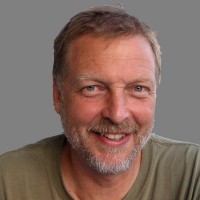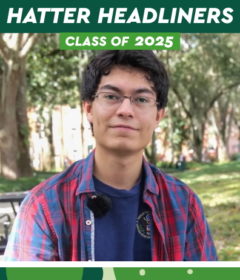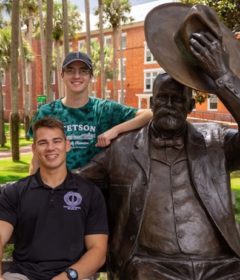Faculty Spotlight: Dr. Robert Sitler
 For Dr. Robert Sitler, professor of Modern Languages & Literatures, the study of Spanish has always been secondary. Language simply opens the door to the opportunity to establish relationships with indigenous people he wouldn’t otherwise have the opportunity to know. Indeed, his encounters with indigenous people of Latin America, most particularly in the Mayan world, have led him to the realization that language is the “clunkiest way of communicating”: if language opens the door to knowing others, it is merely a tool, and a clumsy one at that. At its heart, what Sitler seeks is a spiritual knowledge, a knowledge that has everything to do with awareness and not much, if anything, to do with belief.
For Dr. Robert Sitler, professor of Modern Languages & Literatures, the study of Spanish has always been secondary. Language simply opens the door to the opportunity to establish relationships with indigenous people he wouldn’t otherwise have the opportunity to know. Indeed, his encounters with indigenous people of Latin America, most particularly in the Mayan world, have led him to the realization that language is the “clunkiest way of communicating”: if language opens the door to knowing others, it is merely a tool, and a clumsy one at that. At its heart, what Sitler seeks is a spiritual knowledge, a knowledge that has everything to do with awareness and not much, if anything, to do with belief.
It is thus perhaps not surprising that Sitler voices impatience with academic approaches to knowing the world: too often, he says, “it cannot get at what’s most important.” In fact, his route to a faculty position was more circuitous than most. Initially frustrated with the academic world—of which he had some acquaintance not only as an undergraduate but because his father was a professor of geology—Sitler spent 10 years as a carpenter following his graduation from Kent State. Later, there were practical considerations—he had a young family to support—that led him to pursue the Ph.D. at UT-Austin. As it turned out, it was a very exciting time to be in Austin, as Dr. Linda Schele, a pre-eminent Mayan scholar, was teaching there. Her lectures were so dynamic and engaging that students would cram into the lecture hall until it was standing room only. After earning the Ph.D. with a dissertation written under Schele’s guidance (on how novels set in the Mayan world have put forth distorted representations of Mayan people), Sitler was appointed to the faculty at Stetson in 1994.
 In 2001, Sitler won the McEniry Award for Excellence in Teaching, the highest honor bestowed by Stetson upon a faculty member. In his teaching, he is committed to experiential pedagogies that actively engage students. Part of that strategy is to emphasize the material realities of human life: “it’s not a virtual world, it’s a material world. That changes everything.” He also feels an obligation to communicate that “life has so much more to offer than what we’ve been led to believe.” There are more subtle ways of communicating, and they require paying a different kind of attention to one another. This summer, he will lead a mentored field experience, taking four students with him to Peru for three weeks to experience indigenous life in the Andes. To prepare for the experience, they will meet throughout the spring term, sometimes in Sitler’s own home.
In 2001, Sitler won the McEniry Award for Excellence in Teaching, the highest honor bestowed by Stetson upon a faculty member. In his teaching, he is committed to experiential pedagogies that actively engage students. Part of that strategy is to emphasize the material realities of human life: “it’s not a virtual world, it’s a material world. That changes everything.” He also feels an obligation to communicate that “life has so much more to offer than what we’ve been led to believe.” There are more subtle ways of communicating, and they require paying a different kind of attention to one another. This summer, he will lead a mentored field experience, taking four students with him to Peru for three weeks to experience indigenous life in the Andes. To prepare for the experience, they will meet throughout the spring term, sometimes in Sitler’s own home.
Sitler also attempts to open his students’ eyes to the wonders in the world around them: “We live in paradise, but we go to the malls.” Passionate about free-diving—a form of underwater diving without equipment or breathing devices—Sitler characterizes the experience as a spiritual practice that involves immediacy, physicality, and a calm attentiveness that requires being fully in the moment.
Like his dissertation, Sitler’s recent book, The Living Maya: Ancient Wisdom in the Era of 2012 (North Atlantic Books, 2010) attempts to dispel misconceptions about the Maya. “If I’ve had any contribution to knowledge of the Maya,” he reports, “it’s been translating indigenous voices and perspectives. I never go to ‘study’ these people; I go to learn from them.” He adds, “Nothing has affected my life so much as my encounters with indigenous people. People we perceive to be living in destitution and poverty are living more richly and deeply than people in the U.S.” His work has been praised by such scholars as Vincent Stanzione for its authentic reflection of the Maya in an era of transition; by such writers as Patricio Balona, whose ancestral roots are Mayan; and by Mayan leaders who, like Rigoberto Itzep Chachavac, a K’iche’ spiritual guide, have recognized Sitler’s “great spirit” and “sincere love and respect for Mayan culture.” In the book, Sitler examines the significance of 2012 in Mayan thought, attending to what most 2012 theorists have ignored—the perspectives of the Maya themselves. What he found in his research was an “amazingly consistent message”: the idea that radical change is underfoot; that environmental degradation has broken down traditional ways of being; that we have entered a period of radical change, due to the misuse of the earth; and that these things are unsustainable.
Sitler readily embraces the unfamiliar. When he was very young, his father took the family to the Spanish Pyrenees to collect stream samples. Sitler was alert, even then, to the ways people make connections that don’t require language: at that time he couldn’t understand Spanish, but he did understand that the people were extremely friendly and welcoming. In college, he became intrigued by the radically different world views among indigenous peoples of Mexico and Latin America. More recently, he and his wife, June, had the opportunity to visit their son who is working in Abu Dhabi. Sitler had expected the people to be aloof to American visitors, but found instead that they went out of their way to be kind and gracious. He fell in love with Islam, with the beauty of the culture; he loved waking in the morning to traditional Islamic prayer—in a world with so little reverence, he appreciates it wherever he finds it. He loves Paris, as well, and notes that on a recent trip he relentlessly practiced his French—until the people he met “just couldn’t take it anymore.”
For Sitler, the best part of academic life at Stetson is the freedom he has to be himself, to be as creative as he wants to be, to teach what he loves, and to feel good about the work he does in his scholarship and with his students at the end of the day. “If I complain,” he says, “and sometimes I do, someone really should smack me.”
Photo caption: From left, Belize native Patricio Balona (and News-Journal reporter) who accompanied Stetson’s group, Ashley Palmer, June Sitler, Melissa Pancoast, Jen Wilson, Pedro Zepeda and Robert Sitler visit the ancient Mayan site of Lubaantun in Belize.
By Dr. Karen Kaivola, Associate Provost for Faculty Development
and Professor of English



